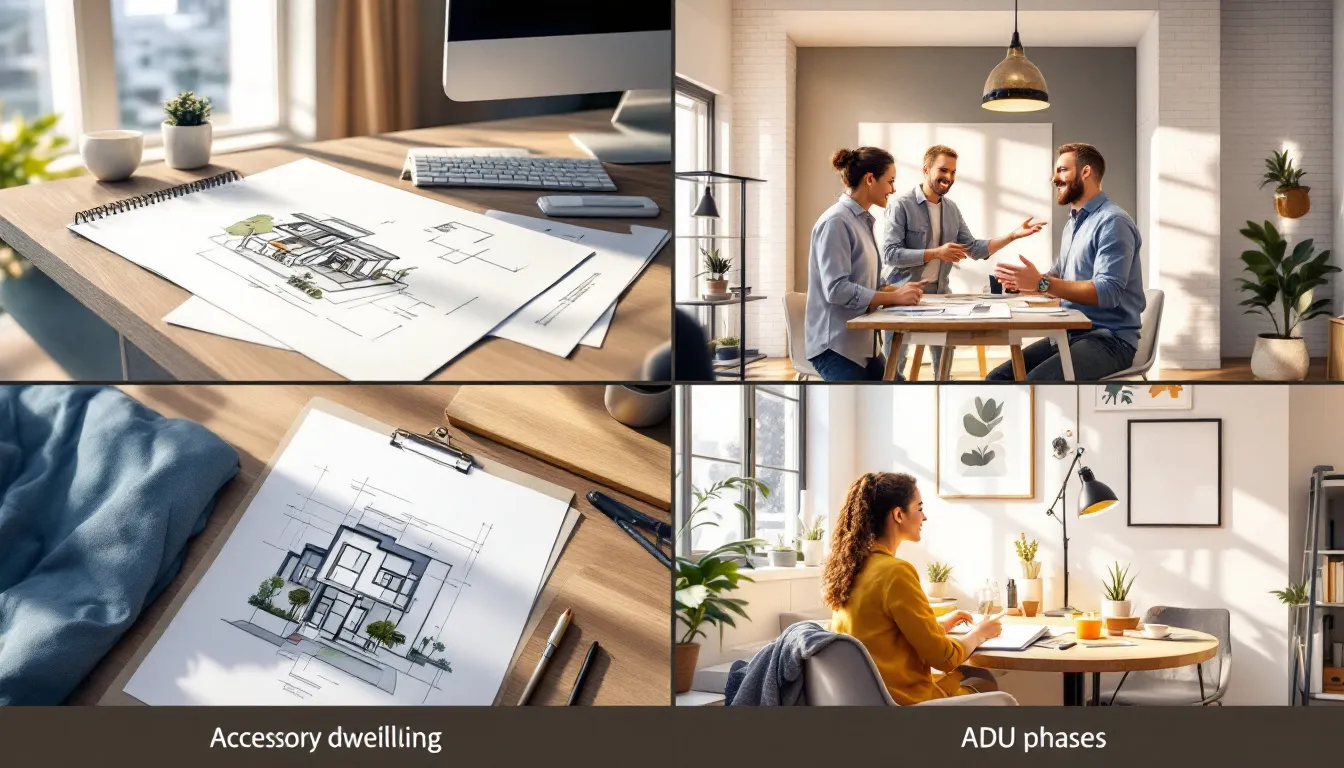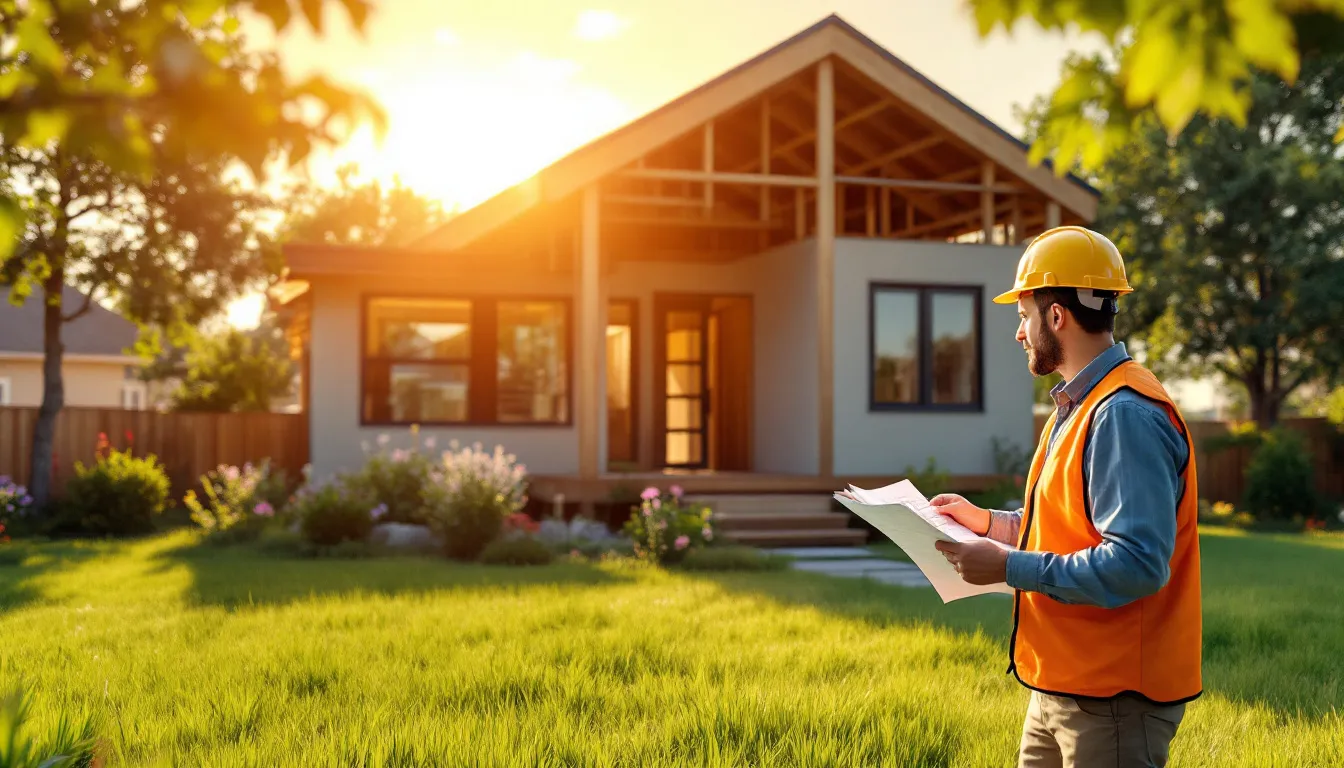: From Planning to Move-In
Building an Accessory Dwelling Unit (ADU) involves several key stages:
- Planning and feasibility check
- Design and permitting
- Site preparation and construction
- Final inspections and move-in
Here's a quick overview of the ADU building process:
| Stage | Duration | Key Tasks |
|---|---|---|
| Planning | 1-2 months | Zoning check, budget planning |
| Design | 2-3 months | Architectural plans, contractor selection |
| Permitting | 3-5 months | Submit plans, address feedback |
| Construction | 5-7 months | Site prep, building, inspections |
| Completion | 2-4 weeks | Final inspections, utility hookups |
Total timeline: Typically 12-15 months from start to finish.
Costs: Expect to spend $200-$275 per square foot for construction, plus additional costs for design, permits, and utilities.
Key tips: • Check local zoning laws before starting • Budget 10-15% extra for unexpected issues • Communicate regularly with your contractor • Stay flexible with materials and timeline
This guide will walk you through each milestone of the ADU building process, helping you avoid common pitfalls and complete your project successfully.
Related video from YouTube
ADU Project Stages
Building an ADU isn't just exciting - it's a journey with clear stages. Let's break down the process so you know exactly what to expect.
Main Building Steps
Here's what goes into building your ADU:
- Site Prep
- Foundation
- Framing
- Exterior Work
- Utilities
- Interior Finishes
- Final Touches and Inspections
Each step is crucial. Let's look at how long this all takes.
Timeline Breakdown
How long will your ADU take? It depends, but here's a rough guide:
| Project Type | Total Time | Construction Phase |
|---|---|---|
| Garage Conversion | 6-12 months | 3-6 months |
| New ADU Build | 12-15 months | 6-9 months |
Remember: This includes everything from planning to final approval. The actual building part is shorter.
Must-Do Steps
Some steps are non-negotiable for a successful ADU:
- Feasibility Study: Is your ADU even possible? Check property rules, zoning, and land before you start.
- Permits: Get them. It takes time, but it's the law.
- Pick Your Contractor: Choose wisely. Get quotes, compare experience and timelines.
- Regular Inspections: Schedule these throughout the build. They ensure everything's up to code.
"Your contractor can make or break your ADU project. Choose someone with expertise and reliability." - Leah Kabli, THE BEST ADU BUILDERS
The ADU Build Flow
Here's how your ADU comes together:
1. Plan and Design
Work with an architect. Create a design that fits your needs and local rules.
2. Get Those Permits
Submit your plans to the city. Be ready for some back-and-forth.
3. Prep the Site
Once you're approved, it's time to clear the land and get ready for the foundation.
4. Build It Up
Now the real work begins:
- Lay the foundation
- Frame it out
- Add exterior finishes (roof, siding, windows, doors)
- Install rough MEP (Mechanical, Electrical, Plumbing)
- Insulate and add drywall
- Finish the interior (floors, cabinets, fixtures)
5. Wrap It Up
Final cleaning, landscaping, and that all-important final inspection for your Certificate of Occupancy.
Before Building Starts
Let's dive into the crucial steps you need to take before breaking ground on your ADU project.
Property Check
First up: make sure your property can actually handle an ADU. Here's what you need to look into:
- Can you even build an ADU in your area? (Zoning laws)
- Is your lot big enough?
- How close to property lines can you build? (Setbacks)
- How tall can your ADU be?
"I've seen so many property owners skip this step. Don't make that mistake! Always check with general contractors about ADU construction costs." - Further Out Group
Design Steps
Got the all-clear? Great. Now it's design time:
1. Hire a pro: Get an architect or designer who knows ADUs inside and out.
2. Figure out your needs: What's this ADU for? Rental? Guest house?
3. Get it on paper: Draw up detailed plans that follow local codes.
4. Tweak and perfect: Refine those plans based on feedback and your budget.
Money Planning
Building an ADU isn't cheap. Here's how to plan:
| Cost Category | Estimated Range |
|---|---|
| Design & Plans | $5,000 - $15,000 |
| Permits | $3,000 - $8,000 |
| Construction | $200 - $275 per sq ft |
In Austin, Texas, a 500 sq ft ADU might set you back about $125,000. Add in utilities and upgrades, and you're looking at around $144,000.
How to pay for it? Consider:
- Home equity lines of credit (HELOC)
- Renovation loans
- Special ADU loans from banks or lenders
Getting Permits
Ah, permits. Not fun, but necessary. Here's the deal:
- Each city has its own ADU rules. Do your homework.
- Get your paperwork ready: site plans, construction drawings, the works.
- Submit and wait. It could take 60 days or more.
- Be ready to make changes if they ask.
Here's a cool tip: Some cities, like San Jose, offer same-day permit approval for pre-approved ADU designs. That can save you a ton of time.
Finding a Builder
This is HUGE. A good builder can make your project. A bad one can break it. Here's how to find a good one:
1. Do your research. Use directories like THE BEST ADU BUILDERS.
2. Get at least three quotes. Compare them carefully.
3. Talk to past clients. What was their experience like?
4. Check those licenses and insurance. Don't skip this step.
"Your contractor can make or break your ADU project. Choose someone with expertise and reliability." - Leah Kabli, THE BEST ADU BUILDERS
Building Steps
Let's dive into the construction process. Building an ADU involves several key stages.
Getting the Site Ready
First, you need to prep the site. This means:
- Clearing out plants and junk
- Leveling the land for good drainage
- Setting up temporary utilities
Leah Kabli from THE BEST ADU BUILDERS says:
"Site prep usually takes 1 to 2 weeks. Don't rush it - it's key for a smooth build."
Building the Foundation
Your ADU needs a solid base. Here's the scoop:
Most ADUs use a slab-on-grade foundation. It's cost-effective. The design depends on your soil and structure needs. Expect this to take 4-6 weeks.
One builder shared:
"The engineer designed a 6" thick slab with 18" wide and 18" deep footings. I hand-dug the footings to save on equipment rental costs."
Building the Structure
With the foundation set, it's framing time. This includes:
- Putting up walls
- Installing roof trusses
- Adding sheathing and house wrap
For a typical ADU, framing takes about 12-14 working days.
Adding Utilities
Now, it's time for the essential systems:
| System | What's Included |
|---|---|
| Electrical | Wiring, panels, outlets |
| Plumbing | Pipes, fixtures, water heater |
| HVAC | Ductwork, heating/cooling units |
This phase usually takes 2-4 weeks. Don't forget: always get inspections before covering up any work.
Inside and Outside Finishing
The final stage brings your ADU to life:
Inside, you'll add insulation, drywall, flooring, paint, and cabinets. Outside, it's siding, roofing, windows, and doors. Then come the final touches: fixtures, appliances, and landscaping.
This phase typically takes 4-6 weeks, depending on your design.
A builder notes:
"After the drywall is up, it's time to wrap this project up! Your crew will move fast to finish the interior, like cabinetry, flooring, paint, and so on."
sbb-itb-4e754d1
Final Steps
You're almost there! Let's wrap up your ADU project with these crucial final steps.
Last Checks
Your ADU needs to pass its final inspection. This is the last hurdle before you can pop that champagne.
The final inspection usually takes 2-4 hours. Inspectors will look at:
- Structural elements
- Systems (electrical, plumbing, HVAC)
- Safety features
- Finishes
Here's a quick breakdown:
| Inspection Area | What They'll Check |
|---|---|
| Structural | Does it match the plans? Any settling issues? |
| Systems | Are all utilities working properly? |
| Safety | Smoke/CO detectors, escape routes |
| Finishes | Completed exterior and interior work |
Start prepping at least two weeks before. You'll thank yourself later.
Approval to Live In
After passing inspection, you'll need a Certificate of Occupancy (CO). This document says your ADU is safe to live in.
The CO:
- Is required for new builds and major renovations
- Shows you've met building codes
- Makes your ADU legal to occupy
- Might be needed for bank loans
Connecting Services
Now it's time to bring your ADU to life with working utilities. This step can be trickier than you'd think.
Here's what you might spend:
| Utility | Typical Cost Range |
|---|---|
| Electrical | $1,000 - $5,000 |
| Plumbing and Sewer | $2,000 - $10,000 |
| Water Supply | $1,500 - $5,000 |
| Natural Gas | $500 - $2,000 |
| Telecommunications | $500 - $2,000 |
"Don't skimp on utility setup. It's the backbone of a functional ADU and worth every penny for long-term comfort and safety." - Leah Kabli, THE BEST ADU BUILDERS
Ready to Move In
You're in the home stretch! Before someone moves in:
1. Test all systems one last time
2. Check ventilation and air tightness
3. Touch up paint and adjust fixtures
4. Deep clean, including construction dust
5. Install any remaining appliances or furniture
Keep up with regular maintenance to keep your ADU in top shape for years to come.
Tips for Managing Steps
Building an ADU is like juggling while riding a unicycle. You've got to keep a lot of balls in the air without falling flat on your face. Here's how to stay on top of things:
Required Papers
Paperwork: it's not sexy, but it's necessary. Here's what you need to keep your ducks in a row:
| Stage | Required Documents |
|---|---|
| Planning | Property deed, site plans, zoning clearance |
| Design | Architectural drawings, engineering plans |
| Permitting | Building permit application, environmental impact reports |
| Construction | Contractor agreements, inspection certificates |
| Completion | Certificate of Occupancy, utility connection approvals |
Pro tip: Set up a digital folder system. It's like having a filing cabinet in your pocket.
Talking with Your Team
Communication is key. Without it, your ADU project could turn into a game of telephone gone wrong.
- Use a project management tool. It's like a virtual war room for your project.
- Have weekly check-ins with your contractor. Think of it as your project's pulse check.
- Be quick to respond. Aim for 24-hour turnarounds to keep things moving.
"Good communication can save you 2.5 hours per project and cut down on 'he said, she said' moments", says Greg Popovich from Goldbar Builders.
Keeping on Schedule
Time is money, and in ADU construction, it's a LOT of money. Here's how to stay on track:
1. Make a detailed timeline. Break your project into weekly chunks.
2. Add some wiggle room. Tack on 10-15% extra time for each phase. Trust us, you'll need it.
3. Track progress daily. Use an app like Buildbite ($85/month) to keep an eye on things.
4. Nip delays in the bud. If something's falling behind, tackle it head-on with your team.
Avoiding Problems
Here are some common ADU headaches and how to dodge them:
| Issue | Prevention Strategy |
|---|---|
| Budget overruns | Stash away 10-15% for surprises |
| Permit delays | Start early, use pre-approved designs if you can |
| Material shortages | Order the important stuff ASAP |
| Neighbor complaints | Give neighbors a heads-up, set clear work hours |
Project Tracking Tools
The right tools can turn you from a frazzled project manager into a cool, calm, and collected one:
- Smartsheet: Great for automating workflows. Starts at $7/user/month.
- Connecteam: An all-in-one app with scheduling and GPS tracking. $29/month for up to 30 users.
- Hubstaff: Combines project tracking with time management. Premium plan at $5/user/month.
Solving Common Problems
Building an ADU can be tricky. Let's look at some common issues and how to fix them.
Common Delays
Delays can mess up your ADU plans. Here's what often causes them:
| Delay Cause | Impact | Prevention Strategy |
|---|---|---|
| Permit issues | Months added to timeline | Start permits early, use pre-approved designs |
| Supply chain problems | Material shortages, higher costs | Order key materials early, be flexible |
| Workforce shortages | Slower construction | Book contractors early, have backups |
"90% of construction businesses report material shortages for components like plywood, framing, and plumbing fixtures." - National Association of Home Builders
Fixing Issues
When problems pop up, act fast:
- Figure out what's wrong
- See how it affects your timeline and budget
- Come up with solutions
- Put the fix in place and watch it closely
Schedule Changes
Sometimes, you need to change your timeline. Here's what to do:
- Tell everyone involved right away
- Make a new schedule with your contractor
- If you're renting out your ADU, let potential tenants know about new dates
Backup Plans
Always have a Plan B:
- Set aside 10-15% of your budget for surprises
- Have another place to stay if you're planning to live in the ADU
- Pick backup materials in case of supply issues
Problem Guide
Quick fixes for common ADU issues:
| Problem | Solution |
|---|---|
| Budget overruns | Check costs weekly, cut extras if needed |
| Zoning restrictions | Use an architect who knows local ADU laws |
| Utility hookup issues | Talk to utility companies early |
| Space constraints | Use multi-use furniture, focus on smart design |
| Contractor conflicts | Keep talking, have regular check-ins |
Most problems have solutions. Stay flexible and keep your eye on the prize: your new ADU.
"To avoid this problem, it's important to get detailed cost estimates before you start the project." - Smith & Sell Construction
Wrap Up
Let's recap the key points of our ADU journey and outline your next steps. Building an ADU is a big project, but with the right prep, you can handle it like a pro.
Main Points
Here's what you need to remember about ADU milestones:
| Phase | What to Know |
|---|---|
| Planning | Check local rules, see if it's doable |
| Design | Make it work well, think long-term |
| Permitting | Start early, it takes 3-5 months |
| Construction | Plan for 5-7 months, expect inspections |
| Completion | Get your Certificate of Occupancy, hook up utilities |
The whole ADU process? It usually takes about a year. In some places, like San Diego County, just getting permits can take 6-8 months for tricky projects.
The National Association of Home Builders says 90% of builders are short on materials like plywood, framing, and plumbing stuff.
This means you need to plan ahead and be flexible with your timeline and materials.
Next Steps
Ready to kick off your ADU project? Here's how to start:
1. Do Your Homework
First, dig into your local ADU rules. In Southern California, you can build ADUs on single-family and multi-family properties, no matter how big your lot is.
2. Budget Smart
Make a solid budget. Add 10-15% extra for surprises. In LA and Southern California, new ADUs usually cost $300 to $400 per square foot.
3. Get the Pros
Talk to ADU experts. Companies like ADU Geeks can help with design and permits, maybe even cutting your timeline in half.
4. Sort Out Money
Check out financing options and get pre-approved. Know what you can afford before you commit.
5. Start Designing
Work with an architect who knows ADUs. Want to move fast? Keep the design simple. Fancy plans can slow things down.
Building an ADU is a journey. But with these steps, you're on your way to adding value to your property and maybe even creating a new home for someone. Good luck!
FAQs
What is the first step to build an ADU?
The first step to build an Accessory Dwelling Unit (ADU) is to dive into local zoning regulations and property requirements. It's not the most exciting part, but it's crucial.
Here's what you need to look into:
- Can you even build an ADU in your area?
- Is your lot big enough?
- Are you looking at a detached or attached ADU?
- Do you need a soils report?
The ADU Ally team from San Jose, California, puts it this way:
"Start by completing the ADU Universal Checklist to see if you are eligible to have an ADU permitted on your property."
Why is this so important? Because it can make or break your project before you even start. For example:
- In California, local governments can take up to 60 days to process ADU permit applications.
- ADU permits in Los Angeles cost about $3,000 on average. But in Pasadena? You might be looking at $20,000.
And here's a scary thought: building an ADU without proper permits is illegal. You could end up:
- Paying to demolish your illegal ADU
- Getting your insurance claims denied
- Watching your property value tank
- Facing civil or criminal charges
So, what should you do?
- Talk to your local planning and building departments.
- Get that soils report if you need it.
- Fill out the ADU Universal Checklist if it's available in your area.
Do these things, and you'll be off to a solid start with your ADU project.


